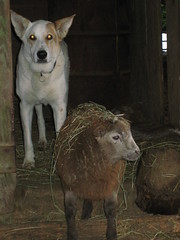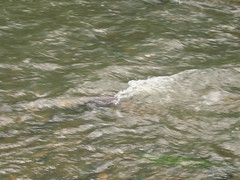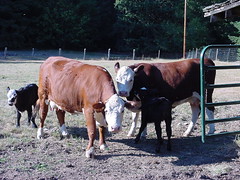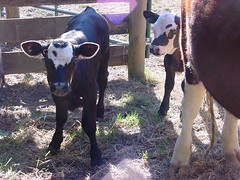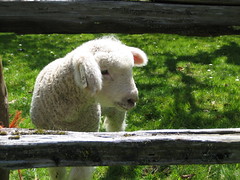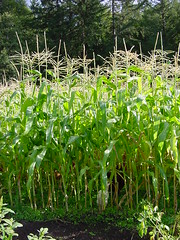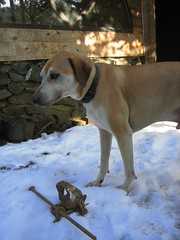
We were walking in the rain. We walk every morning whether it is raining or foggy or cold or clear. Rain in the Oregon Coast Range is often what I would call an English mist. Today we were walking in an English mist.
We walk to keep fit, to chase away osteoporosis, to clear the brain for the day, to chatter about whatever comes to mind - books, families, community, gossip, even weather. We also, or maybe here I should say "I", walk for the dogs. Patches and Cisco live to walk. You can tell it in the way they yelp when I grab the keys to the truck or my walking buddies arrive at the front door. It is a yelp of excitement: "You're here! Yippee! Let's go! Hurry up!" These are happy dogs.
I have never quite understood this level of excitement. It would make sense if the dogs were kept inside every day, but these dogs have their own dog door. They can come and go as they please. They can eat sheep poop in the orchard, chase chipmunks hiding in the raspberry bushes, surreptitiously herd sheep, run down the driveway to bark at passing cars on the gravel road - mostly all without being scolded. But, look like you might be going out for a walk and our dogs start to bounce around, underfoot, at the door, pleading and whining, "Me too; me too!"
When we walk in the woods, it is not like the "walkies" of that funny English lady on TV years ago. It's the off-the-leash walks up the logging roads, some recently rocked to keep the trucks from sinking in the mud; others left unused and starting to cover with soft grasses and fallen pine needles. This day, we chose a logging road with more tender footing and no trucks. We call it the 'Graveyard' road because the locals have the bad habit of dumping fresh carcasses of game they have killed, either legally or illegally. There are bones everywhere. Archaeologists a thousand years from now will wonder if the 21st century residents of the Alsea Valley practiced ritual slaughter. To bring us sun? To bring us oil? To bring us closer to God? We call it the Graveyard road because it is peacefully quiet...and dead.
Not so peaceful. One of my dogs was shrieking. Shrieking in pain or fear. Whatever it was, he kept screaming and screaming. I couldn't see him, but I started to run into the dark, dank woods. Off the road. Towards the terrible noise. My first thought was the dog had had an encounter with a porcupine. I saw him in the gloom, at the base of a large snag. Why wasn't he running back to me? Did something have a hold of his face? My mind raced next to thoughts of a badger or a raccoon, jaws holding him tight. But his face turned toward me from time to time as he screamed. His paw was caught. In a hole? Under a root? Cisco is such a baby about his feet and anything touching them. I crouched beside him throwing off my gloves and reaching for his paw. It was only then I realized Cisco was caught in the vise-grip of a leg-hold trap, baited with the very bones that named our road.
As I pushed against Cisco to stop him pulling harder against the trap, I thought about coyotes, known to bite off a foot to get out of a trap. Cisco was panicked. What would he do? I put my arms around him from behind and tried to keep him secure while I struggled to press down on one side of the trap. I could barely make it move and, by pressing down on only one side, I pinched Cisco's paw harder. He screamed. I was not strong enough to hold the dog and open the trap. I wasn't sure I was even strong enough to open the trap at all.
My friends had stayed on the road as I bounded thoughtlessly into the woods to save my dog. After all, it could have been a cougar attack, though this never crossed my mind. I yelled for help. Nancy came running. Janet hesitated, still unsure about the wisdom of entering the forest. Nancy crouched beside me and called to Janet again. I knew now how the trap worked and babbled what I needed. Both women looked at me in confusion. I tried to explain. Cisco yelled and struggled, his large teeth just inches from their faces as they bent over the trap. I grabbed his muzzle and pointed his head away. "Push! Push hard!" The first attempt failed. Were none of us strong enough? "Try again! Lean down on it! With all your weight!" Now I was panicked. The adrenalin kicked in for all three of us as Nancy and Janet pushed hard on the springs. The trap opened enough for me to pull Cisco's paw free; then it snapped shut again, this time on itself.
I let Cisco go and stood up shaking. He sat down to lick his paw, then looked up expectantly. "Can we go now?" There was no three-legged hopping. Cisco scampered toward the road. "I'm okay. My feet are okay. No, you cannot take a look. Let's get out of here!" I figured his adrenaline was probably so cranked he couldn't feel pain yet. I thanked Nancy and Janet and realized I was still babbling. I needed to get Cisco home to take a look at his paw and then to a vet. I needed to sit down. I needed to calm myself. I don't even remember saying good-bye as I started to walk back down the road to the car.
As I walked, I was surprised my hands had become so cold so fast. I had put my gloves back on and was now aware of that tingling sensation you get when you warm your hands too fast next to the fire. I pulled my gloves back off. My right hand was covered in blood mixed with the grimy dirt from the forest floor. There was some on Cisco's face too. Where had he been cut? I didn't see any blood on his paw. Slowly, I realized I was the one who was bleeding. In the confusion, Cisco had bitten me and I hadn't even felt it.
Four weeks later, I still have purple under my thumbnail, a mark from one tooth on the side of it, and a prescription in my wallet for antibiotics I never had to take. Cisco ended up being the luckiest of dogs. The vet was amazed he had no broken bones, although getting a look at his foot was a trick in itself, requiring a muzzle, a blanket and three people. Our youngest daughter returned with me to find the sprung trap, except it had been reset! It took two of us, but we were able to pull out three feet of rebar holding it in the ground and then carried the trap back to our house because it had been set illegally. I had already checked with the logging company that owned the ground. Yes, they had trappers, but this was not one of them. They didn't want to tell me what to do about the trap, but did say, come spring, there would be active trapping in the area for beaver devastating their recently planted Douglas fir forest.
I have since warned my neighbors. Most of us hike in the woods with our dogs. Most of us don't think about traps as a hazard on these outings. I'm not sure how to proceed with this new knowledge that there is something called a fur license to trap beaver or coyotes or bobcats or any other animal that trips the metal jaws. I can't understand it myself because it's not in my nature, this trapping thing.
I call more often now for Cisco and Patches to stay close when we walk, especially when we near the Graveyard road. As they dash into the dark of the forest, I hold my breath and wait for the sound of screaming. I whistle until I see the bounding bodies, the wagging tails, the frosted breath as both dash towards me, "We're here. What do you want? Why don't you trust us? We're happy dogs!" I exhale, then rejoin the conversation with my friends, as we continue down the logging road.
(Cisco is standing next to the leg-hold trap we yanked from the forest floor. It was bigger than I remembered. Oh, yeah, the name of this chapter is an intentional play on Al Gore's movie An Inconvenient Truth...sign of the times)
All rights reserved. Copyright 2007 Scottie Jones
...Click here to read the rest of this post.


